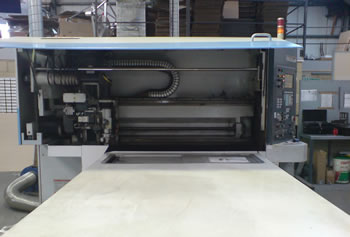Laser Cutting
Laser cutting is a technology which uses a laser to cut materials, and is usually used in industrial manufacturing.
Laser cutting works by directing the output of a high power laser at the material to be cut. The material then either melts, burns or vaporizes away leaving an edge with a high quality surface finish.
Advantages of laser cutting over mechanical cutting vary according to the situation, but important factors are: lack of physical contact (since there is no cutting edge which can become contaminated by the material or contaminate the material), and to some extent precision (since there is no wear on the laser). There is also a reduced chance of warping the material that is being cut as laser systems have a small heat affected zone. Some materials are also very difficult or impossible to cut by more traditional means[1]. Disadvantages of laser cutting may include the high energy required.
The most popular lasers for cutting materials are CO2 and Nd:YAG, though semiconductor lasers are gaining prominence due to greater efficiency.
Industrial laser cutters are used to cut flat-sheet material as well as structural and piping materials. Some 6-axis lasers can perform cutting operations on parts that have been pre-formed by casting or machining.
Laser cutters usually work much like a milling machine would for working a sheet in that the laser (equivalent to the mill) enters through the side of the sheet and cuts it through the axis of the beam. In order to be able to start cutting from somewhere else than the edge, a pierce is done before every cut. Piercing usually involves a high power pulsating laser beam which slowly (taking around 5-15 seconds for half inch Stainless Steel, for example) makes a hole in the material.
 There are generally three different types of industrial laser cutting machines. Flying Optics lasers usually feature a stationary X and Y axis table where the cutting laser moves over the work piece in both of the horizontal dimensions. Flying Optics is popular due to the low cost of stationary tables, and their higher cutting speed limits, since the mass of the optics is much smaller than the mass of the table.
There are generally three different types of industrial laser cutting machines. Flying Optics lasers usually feature a stationary X and Y axis table where the cutting laser moves over the work piece in both of the horizontal dimensions. Flying Optics is popular due to the low cost of stationary tables, and their higher cutting speed limits, since the mass of the optics is much smaller than the mass of the table.
Both Hybrid and Pivot-Beam lasers usually involve a table which has the capability of X axis travel. Because of this, the head has to move only in two directions (usually the ones with the shortest runs), thus improving its efficiency, as the path traveled is shorter. Pivot-Beam lasers offer the highest performance per watt and the most reliable cut consistency of the three styles.
Pulsed lasers which provide a high power burst of energy for a short period are very effective in some laser cutting processes, particularly for piercing, or when very small holes or very low cutting speeds are required, since if a constant laser beam were used, the heat could reach the point of melting the whole piece being cut.

